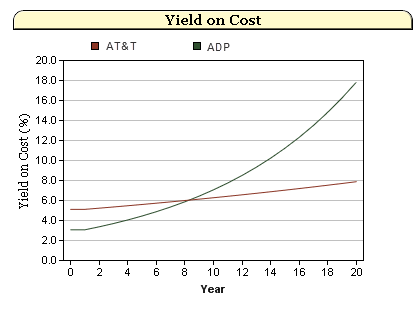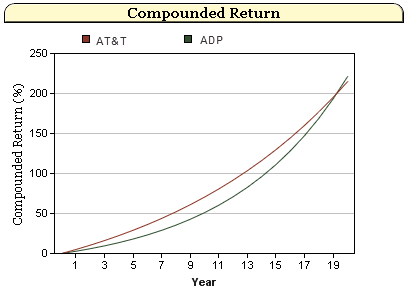When looking to build a long-term portfolio of stocks that pay high dividends, investors usually come up with a mix of stocks that either have high dividend yields or high dividend growth rates. It is difficult to find good companies that have both. This means that there is often a choice to be made. All else equal, should one invest in the company that has that enticing high dividend yield, but a low dividend growth rate, or does one exude patience and invest in the company with a relatively low yield, but a high dividend growth rate? To help answer this question I looked at two companies that offer these different alternatives: AT&T (T) and Automatic Data Processing, Inc. (ADP)
| T: | | Div Yield | 1 Yr Div
Growth Rate | 5 Yr Div
Growth Rate | | 5.0% | 2.3% | 4.8% | | | | ADP: | | Div Yield | 1 Yr Div
Growth Rate | 5 Yr Div
Growth Rate | | 2.8% | 9.7% | 14.3% | |
There are clear differences in the two companies’ dividend yields as well as the growth rates. This presents a great case study in which company will give the investor a greater return due to dividends over time. More specifically, I want to measure the Yield on Cost (YOC) and how it changes over time as well as the compounded annual return due to dividends. The YOC simply measures the annual dividend divided by the original investment in the company’s stock.
The five year growth rate of dividends for ADP far exceeds that of AT&T. However, I do not expect the growth rate to remain that high going forward, especially over a long time frame. To be more realistic, I will assume that ADP’s dividend grows at the one year rate of 9.7% and AT&T maintains a growth rate of 2.3%. I ran the following results in our free calculator called Dividend Yield And Growth.

It takes 9 years for the YOC for ADP to break even with the YOC for AT&T. Of course, due to compounding we see the YOC for ADP explode upward eventually. But this assumes that the company can continue its relatively high rate of dividend growth going forward.
Although the yield on cost breaks even after nine years, it takes much longer for the compounded total returns to break even. In fact, it takes 19 years for the returns to break even. It is also important to note that I do not consider any price appreciation in these calculations and compounded returns are due solely to dividends.

This is an interesting case study in dividend investing because we can see that by investing in ADP for its dividends, one would be betting on the company maintaining a high level of dividend growth. If this doesn’t happen, there are better alternatives out there for dividend investors. So investors in ADP should keep a close eye on the dividend growth rate.
It is also important to point out that dividend paying stocks such as ADP and AT&T can help a retirement plan immensely, especially vs. low-yielding treasury bonds. I plugged in the two stocks I analyzed here I into our retirement planner in place of the ten treasury bonds that were in the portfolio before.
I found that if a typical 55 year old couple with $400,000 in assets moves 50% of their funds from treasuries to dividend payers such as AT&T and ADP, over ten years they will have increased the time that their funds last in retirement by over 10 years.
When constructing a dividend portfolio for the long-run, it is important to keep in mind just how important both the dividend growth and the yield are over time. Selecting companies which have consistently strong dividend growth over long time periods can mean the difference between early retirement and working a lot longer.